Many wonderful artists have influenced me over the course of my long career. In writing this article, initially for TextileArtist.org, I enjoyed lingering with the memories of these and other friends like my first California weaving teacher, “our Mary Black,” my good friend Ulla De Larios, whose artistry and dedication to our craft never ceases to inspire me, and so many other wonderful teachers at CNCH conferences. Here are stories about the five that perhaps had the strongest influence on the artist I have become.
My mother Esther Zipser was an artist and naturally she was an influence from my earliest days, but I suppose the first person I think of in this context is her dear friend Rose Tamler. Rose is a beautiful weaver whose elegant hand woven clothing, which she still wears, taught me as a young girl growing up in San Francisco that handcrafted textiles could be ever so much more interesting than department store purchases. Rose was ahead of her time, her work falling into the tradition of Asian inspired European couture with classic garments crafted with refinement and style. I was not yet a weaver in the mid 1960s, but I probably studied couture sewing in Lausanne, Switzerland so that I could one day fashion hand woven cloth into garments as Rose did. I do not have any photos of Rose’s clothing, but her work includes this table runner she wove for my parents and that I treasure to this day. Rose’s artful clothing was my inspiration to become a weaver in the 1970s and for that I am so very grateful.
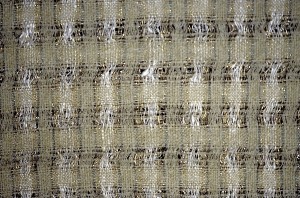
Rose Tamler
Table Runner
Eventually I was ready to move on from art clothing to woven artwork, so I studied with Candace Crockett at San Francisco State University in the early 1980’s and continued there some 25 years as her teaching assistant. I never tired of listening to her lectures. From Candace I learned the many means of putting color on cloth, including indigo, and so much more.
Techniques once mastered became tools for expressing my immerging artist voice. Candace gave me the courage to take artistic risks. I no longer feared putting precious hand woven cloth into a dye pot. Tailoring training had taught me that some cloth has to be cut away for a proper fit. Candace taught me to relish unexpected results from the dye bath, which became a source of inspiration.
With experience came confidence as Candace allowed me to maintain the indigo vats at SFSU for many years. Indigo has continued to be the focus for much of my artwork. Candace’s passion for all aspects of textiles has inspired my own. Candace’s artwork is often made of multiple card woven bands. The scale can be small and intimate or large and dramatic, but always harness the expressive qualities of light, color and the natural twisting that occurs. Candace continues to explore her chosen technique and still finds new and poignant variations on this theme.
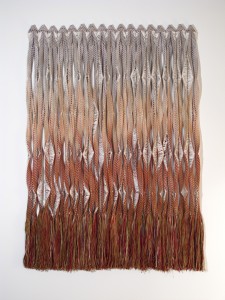
Candace Crockett
‘ Dancing ‘ 2011
While at SFSU, I was fortunate to study with Pat Hickman, and what I learned was formative. Pat encouraged us to look deeply into historical and ethnic textiles and techniques and the elementary structures of interlacement including netting and knotting. The expressive concept of structure and skin she explored with Lillian Elliott has continued to resonate with me. In retrospect I realize that Pat taught in the spirit of her own teachers Ed Rossbach and Elliott. I studied Comparative Literature at UC Berkeley when they taught in the Design Department, but our paths never crossed. Although I certainly missed a great opportunity at Berkeley, Pat introduced me to the Rossbach philosophy of looking at textiles of the past as a portal to contemporary work. I have followed Pat’s artwork thoroughly over the years and admire her ability to express deeply felt emotions.
Pat’s work primarily revolves around animal membranes, inspired initially by waterproof intestine parkas worn by the native people of coastal Alaska. Her translucent works are both fragile and powerful. Lost in Translation, a bronze casting of an incomplete netted basket is one of the most powerful pieces I have ever experienced, an almost palpable rendering of grief. I owe much to Pat’s influence and her ability to look at both materials and technique with an open and creative mind.
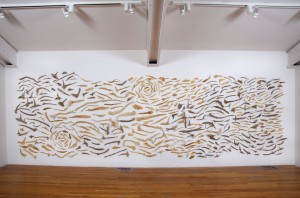
Pat Hickman
‘The River that Flows Both Ways’ 2015
More recently, two basket artists whose work moved me had a profound influence, and coincidentally they too were teachers with whom I have continued to have enriching relationships. I took Lissa Hunter’s Embellishment workshop in 2002 with the idea of learning techniques I could translate to my woven work. Lissa took one look at my portfolio and said, “Oh no, you can’t work on those purchased baskets you brought, I’ll teach you to coil, you’re going to love it, I used to be a weaver too.” Fateful words that proved so true.
Lissa’s mentoring has encouraged me to be honest in what I want to say with my artwork, and to speak only in my own true voice. As with many artists I admire, Lissa’s mastery of technique allows her to concentrate on concept. In her sculptural basketry, the coiled object becomes a vehicle for storytelling. The simple cup shapes are installed on shelves or in niches forming installations often with enigmatic drawing on the surface. Coiling gives structure to a complex interplay of shape and finishes. Lissa’s works are moving, sometimes playful and always beautiful. She has recently turned her refined drawing skills to porcelain cups that replace the coiled vessels in some new installations: not a reinvention of self, but her same clear voice in a new material.
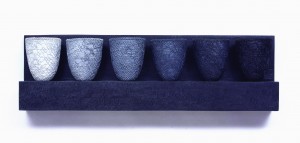
Lissa Hunter
‘Fade to black’ 2004
After years of working in coiling, I studied plaiting with Nancy Moore Bess in 2007, and finally made the jump from soft fibers to elements where a play between stiffness and flexibility can create open forms. Nancy has remained a staunchly uplifting friend, and one I can rely on to tell me the truth about where my basket explorations have led me. I was impressed by her ability to work in the Japanese vernacular acquired while she lived in Japan. She expresses her understanding of this tradition in a uniquely personal way. She was fascinated by the complex concept of Japanese package wrapping. Her work speaks about containment and all that is hidden and revealed with bamboo structures allowing glimpses of twined forms inside. Shedding the bamboo cages that initially caught my eye, Nancy also creates larger sculptural twined forms that are sometimes influenced by Japanese iconography, but are open to interpretation by the viewer. Her mastery of varied twined surfaces informs these unique sculptures. Seeds, pods and pollen inspire some of her newest work. A gifted artist in another medium, Nancy is also exploring new pathways with sensitive stitched works.
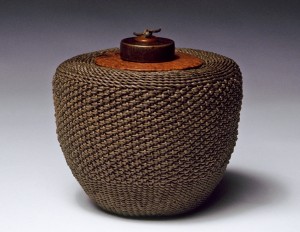
Nancy Moore Bess
‘Cha Tea Jar’ 2003
Now when I create indigo-dyed or draped baskets, anthropomorphic forms, nests or boats, or when I sit down to weave at the loom again, as I recently did, I feel as if I have come full-circle from the draped and tucked garments from my art-wear days. The three-dimensional form is once again what fascinates me. I think the ability to express emotion with materials and technique is what makes a textile a work of art. The importance of continuing to take artistic risks and explore new ideas is paramount. I have been inspired by these artists to keep on challenging myself as they do. How lucky I am to have had such inspiring artists as my mentors and friends!
Barbara Shapiro has taught textile classes at San Francisco State University and for Osher Lifelong Learning through SFSU. She is a past board member of the Textile Society of America and an advisor to the Textile Arts Council of the Fine Arts Museum of San Francisco. She has devoted much of her art practice to basketry for the past fourteen years, working in both coiling and plaiting, often with indigo dyed elements.
For more information visit: www.Barbara-Shapiro.com
Candace Crockett https://genevaanderson.wordpress.com/2013/02/
http://www.amazon.com/Card-Weaving-Candace-Crockett/dp/0934026610
Pat Hickman www.pathickman.com www.nationalbasketry.org
Lissa Hunter www.lissahunter.com
Nancy Moore Bess www.nancymoorebess.com